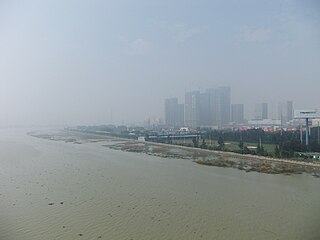
King Ling of Zhou,personal name Ji Xiexin,was a king of the Chinese Zhou dynasty. He died in 545 BC.

The Kingdom of Tungning,also known as Tywan by the English at the time,was a dynastic maritime state that ruled part of southwestern Taiwan and the Penghu islands between 1661 and 1683. It is the first predominantly ethnic Han state in Taiwanese history. At its zenith,the kingdom's maritime power dominated varying extents of coastal regions of southeastern China and controlled the major sea lanes across both China Seas,and its vast trade network stretched from Japan to Southeast Asia.
Fung Fung was a veteran Hong Kong actor. He began his career as a leading man in 1946. An accident in 1949 left the left side of his face paralysed,but,while no longer able to attract leading roles,he enjoyed a long career as a character actor,appearing in films alongside such stars as Jackie Chan and Sammo Hung. He was the father of Fung Bo Bo,a child star of the 1960s,Alice Fung,a veteran actress,and Fung Hak-On,an actor known for playing villainous roles in several kung fu/action comedies of the 1970s and 1980s.

The China Theatre Plum Blossom Award,more commonly the Plum Blossom Award,is the highest theatrical award in China. It is awarded by the China Theatre Association.

Romance of the Three Kingdoms is a Chinese television series adapted from the classical 14th century novel of the same title by Luo Guanzhong. The series was produced by China Central Television (CCTV) and was first aired on the network in 1994. It spanned a total of 84 episodes,each approximately 45 minutes long. One of the most expensive television series produced at the time,the project cost 170 million yuan. It was completed over four years and involved over 400,000 cast and crew members,including divisions of the People's Liberation Army from the Beijing,Nanjing and Chengdu military regions. Some of the dialogue spoken by characters was adapted directly from the novel. Extensive battle scenes,such as the battles of Guandu,Red Cliffs and Xiaoting,were also live-acted.
The Old History of the Five Dynasties was an official history mainly focusing on Five Dynasties era (907–960),which controlled much of northern China. And it also includes some history of other south states during the era. It was compiled by the Song dynasty official-scholar Xue Juzheng in the first two decades of the Song dynasty,which was founded in 960. It is one of the Twenty-Four Histories recognized through Chinese history.

Ancient Chinese coinage includes some of the earliest known coins. These coins,used as early as the Spring and Autumn period (770–476 BCE),took the form of imitations of the cowrie shells that were used in ceremonial exchanges. The same period also saw the introduction of the first metal coins;however,they were not initially round,instead being either knife shaped or spade shaped. Round metal coins with a round,and then later square hole in the center were first introduced around 350 BCE. The beginning of the Qin dynasty (221–206 BCE),the first dynasty to unify China,saw the introduction of a standardised coinage for the whole Empire. Subsequent dynasties produced variations on these round coins throughout the imperial period. At first the distribution of the coinage was limited to use around the capital city district,but by the beginning of the Han dynasty,coins were widely used for such things as paying taxes,salaries and fines.

The Pagoda of Bailin Temple,is located in Zhao County,Hebei. It is an octagonal-based brick Chinese pagoda built in 1330 during the reign of Emperor Wenzong,ruler of the Mongol-led Yuan Dynasty.

Three Kingdoms is a 2010 Chinese television series based on the events in the late Eastern Han dynasty and the Three Kingdoms period. The plot is adapted from the 14th century historical novel Romance of the Three Kingdoms and other stories about the Three Kingdoms period. Directed by Gao Xixi,the series had a budget of over 160 million RMB and took five years of pre-production work. Shooting of the series commenced in October 2008,and it was released in China in May 2010.

The Jin River,also known in Hokkien Chinese:晉江;Pe̍h-ōe-jī:Chìn-kang;Mandarin Chinese:晉江;pinyin:Jìnjiāng,is located in southern Fujian. Its basin includes most of Quanzhou prefecture-level city,whose Jinjiang County-level City is named after it.

Justice Bao is a Chinese TV series starring producer Jin Chao-chun as the Song dynasty official Bao Zheng. The series ran for 3 seasons from 2010 to 2012. In addition to Jin,Kenny Ho,Fan Hung-hsuan and Lung Lung again reprise their iconic roles from the 1993 Taiwanese hit Justice Pao and the 2008 Chinese series Justice Bao.
The House of Li was the ruling house of the Western Liang dynasty and the Tang dynasty of China.

Empresses in the Palace is a 2011 Chinese television series based on the novel of the same name by Liu Lianzi. Directed by Zheng Xiaolong,it stars Sun Li in the title role.
The Legend of Crazy Monk is a Chinese television series about the life of Ji Gong. The series was directed by Lin Tianyi and based on Guo Xiaoting's classical novel Biography of Ji Gong. It was a hot TV series recently in Guangdong Television,Jiangsu Television and Shenzhen Television. It is shown on Mediacorp Channel 8 at 7pm.

Loving,Never Forgetting is a 2014 Chinese television series starring Jerry Yan and Tong Liya. It is based on the novel Wu Ai Cheng Huan (无爱承欢) by Lan Bai Se. The series was broadcast by ZJSTV from 23 June to 5 July 2014 for 34 episodes.
The China Badminton Super League (CBSL) (Chinese:中国羽毛球俱乐部超级联赛) is the prime National team competition for badminton players in China. The China Badminton Super League was re-launched in 2009 after a failing attempt seven years earlier. Liu Fengyan,director of the Table Tennis and Badminton Administration Center under China's State General Administration of Sport,announced the re-launch during the 50th anniversary meeting of the Chinese Badminton Association.

Sun Yueh was a Taiwanese actor.
Events from the year 1663 in China. Also known as 壬寅4359 or 4299 to 卯年4360 or 4300 in the Earthly Branches calendar.












